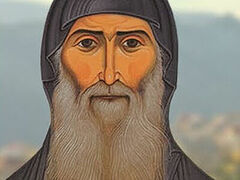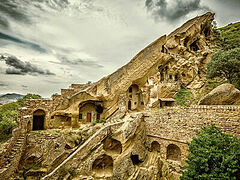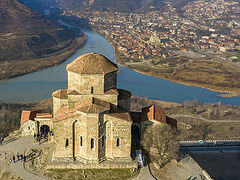Last summer we visited Georgia. The purpose of our trip was for treatment with magnetic sands by the river. But we also wanted to fulfill our long–held dream of visiting Georgia and venerating the relics of St. Gabriel (Urgebadze), whom we greatly venerate. Georgia is the first earthly portion of the Most Holy Theotokos! It fell to Her lot to go there to preach the Word of God (Mt. Athos is Her second portion, Kiev is the third, and Diveyevo is the fourth). Besides, I wanted to visit the mountains of Georgia.
And so our dream came true: my wife, our son and daughter and I went on vacation.
On the second day of our stay in Georgia we rented a car for a low price. For some time after our arrival we lived in an old neighborhood of Tbilisi not far from the Holy Trinity Cathedral. Undoubtedly, it is an impressive edifice!
 The Holy Trinity Cathedral of Tbilisi
The Holy Trinity Cathedral of Tbilisi
How they sing at services
I was surprised that in some churches they don’t sing at all, but recite all the prayers in a monotonous voice, even Our Father and the Creed.1 However, in some churches they sing and there are choirs. But surprisingly, Our Father and the Creed are not sung in them either, but read in a monotonous voice by the whole congregation simultaneously. In one large church the entire service was read in a monotone, and I without any knowledge of Georgian could not tell which was the Hours and which was the Liturgy, and I was surprised when Holy Communion began. There are people in churches—they are not empty—but at the same time it is clear that in Georgia, like in Russia, the majority of population are not church-goers.
St. Gabriel Urgebadze) of Samtavro
Father Gabriel is highly venerated in our family. This saint has held a special place in my heart since I read my first books about him. It so happened that we visited Father. Gabriel twice. The fact is that Samtavro Convent is situated not so far from Tbilisi and rather close to a highway (we came to him for the second time on the way to Ureki resort). We venerated the relics, prayed, bought some blessed oil, icons, and a book in Russian translation…
By chance I heard that in Tbilisi you can visit the house where St. Gabriel used to live before becoming a monk and where he built a church with his own hands. This place is located at 11 Tetritskaro Lane. We were not allowed inside, but we visited the church and the yard of batiushka’s house.
 The church built by St. Gabriel in the yard of his house
The church built by St. Gabriel in the yard of his house
 The church built by St. Gabriel in the yard of his house
The church built by St. Gabriel in the yard of his house
Mtskheta
We visited the ancient city of Mtskheta, which was once the capital of Georgia. It is close to Samtavro Convent.
 Svetitskhoveli was the principal church of Georgia prior to the construction of the Holy Trinity Cathedral in Tbilisi.
Svetitskhoveli was the principal church of Georgia prior to the construction of the Holy Trinity Cathedral in Tbilisi.
Reference:
Mtskheta was the ancient capital of Georgia. In the fourth century A.D., St. Nino Equal-to-the-Apostles had the Iberian King Mirian III baptized here and advised him to build a wooden church on this site. In the fifth century it was replaced by a stone basilica, fragments of which have survived to this day. Svetitskhoveli means the “Life–Giving Pillar” in Georgian. It was here, in Mtskheta, that according to tradition St. Nino discovered a cedar tree, under the roots of which the Lord’s Tunic had been hidden. The miraculous pillar of that cedar tree became the first pillar of the cathedral. In Georgia they believe that the Lord’s Tunic is still under the church. Many kings and Patriarchs of Georgia are buried at Mtskheta Cathedral. Some of the greatest holy relics are kept here: fragments of the True Cross, the mantle (cloak) of the Prophet Elias, and a particle of the relics of the Apostle Andrew the First-Called.
Inside the cathedral there is a church—a replica of the Edicule situated over the Tomb of Christ at the Church of the Holy Sepulcher in Jerusalem.
We also visited the Church of St. Nino in the Kakheti region, where her relics are kept.
David Gareja
But I was particularly impressed by the David Gareja Monastery complex. It is a chain of mountain cave monasteries on the border with Azerbaijan, where one of the most venerated saints of Georgia, the Syrian monk St. David of Gareji, struggled in the sixth century. There is stunning territory and fabulous scenery around the monastery. They write that it is unbearably hot here in summer, and biting winds blow here in winter.
 View inside David Gareji Monastery
View inside David Gareji Monastery
 View inside David Gareji Monastery
View inside David Gareji Monastery
 Surroundings of David Gareji Monastery
Surroundings of David Gareji Monastery
Hotel in Ureki
When we were checking into the hotel, at the reception desk I saw an icon made by our Simvolik icon manufacturer! There was a similar situation when I first sailed to Mt. Athos from Ouranoupolis and dropped in at some shop. I saw our icon near the cash register (it wasn’t for sale). In both cases, the owners explained that they had been given the icons by a “priest from Russia”…
Let me remind you that both Georgia and Holy Mount Athos are portions of the Most Holy Theotokos. It was such a consolation! Glory to God for everything!
 Icon from Simvolik at the hotel in Ureki
Icon from Simvolik at the hotel in Ureki
Ureki is a unique place where there are beaches of black magnetic sand, which cures many diseases. By the way, I was cured there of the cough that plagued me for two months after I had volunteered at a military hospital in Makeyevka. Glory be to God!
The arboretum
I was impressed by the arboretum, which was created by the Georgian billionaire Ivanishvili in Shekvetili. Giant ancient survivor trees grow there, brought from all over Georgia and from other countries.
On the Georgians and the Georgian way
It is very noticeable that there are attempts to instill some strange trends in people.
On a Russian-language travel channel, a girl said: “I don’t want to be a girl, I to be a boy.” To what purpose are such things being said on a tourist channel?
At the same time, ordinary people in Georgia are very nice; for instance, the hostess of a guest house where we spent the night after visiting David Gareji Monastery, a widow with many children, who fed us for free and showed us great love; and as a watermelon vendor in one of the villages, who lovingly received us in the yard of his house. These people left a deep mark on my soul.
The Russian language
There are many Ukrainians, Belarusians, Russians and other natives of the former USSR living in Georgia who all speak Russian.
Russian is spoken everywhere in Georgia! In fixed-route taxis, at markets, in stores—no matter how far you are from the beach… In cities, songs in Russian are played at high volume in passing cars. A fixed-route taxi driver intentionally turned on Russian music for his passengers.
A story with St. Gabriel’s icon
In Georgia we bought a book on St. Gabriel, and I read it to my family before going to bed (I always read books to my children before sleep, and the Holy Scriptures to the whole family—I consider it a very important thing). In the book, eyewitnesses who personally knew Fr. Gabriel say that very often his photographs, depending on your behavior, would curl up or straighten out, or Fr. Gabriel would start looking in a special way in the photo, even wink.
Of course, we bought ourselves an icon and had it blessed on the saint’s relics. And that’s what happened one day: my ten-year-old daughter’s friends came to our place and played in the room where Fr. Gabriel’s icon stood. Suddenly they ran out frightened: “Look, an icon is winking at us!” I assure you that my daughter’s friends never read the book on Fr. Gabriel…
Conclusion
Now Georgia is under the onslaught of dark forces. Let us pray to the Lord and the Most Holy Theotokos, St. Gabriel of Samtavro and all the saints of the Georgian land that they will protect the holy land of Georgia!










